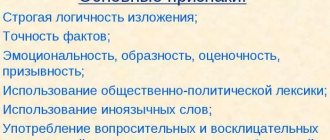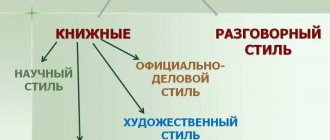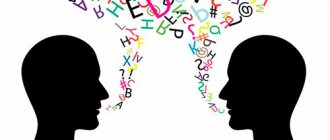The journalistic style of speech is a unique way of influencing huge masses of people. It is this type of text that can be seen in various newspaper articles, magazines, and other sources that express major social problems.
Substyles of journalistic style:
- newspaper and journalistic;
- television journalist;
- radio journalistic;
- direct contact with the audience.
Signs of journalistic style
You can understand that this is the style of speech in question by the following features:
- The validity and validity of statements that are used in speech. That is, the author of the text does not intend to distort reality in any way, but, on the contrary, strives to show the real sides of social life.
- Sentences in the text must be logically connected. People to whom the text is addressed in a journalistic style must clearly understand the problem of the text, its meaning and main idea in order to draw the right conclusions for themselves.
- Using a large number of questions and exclamations to decorate speech during a speech. Such articles are the most motivating and attract society.
- The text is filled with emotions and the author’s evaluative suggestions regarding the problem of speech. Speech is capable of influencing a huge class of people, therefore the text must be for the people. This is what distinguishes the journalistic style of speech from such styles as scientific, business or artistic. It uses colloquial language tools that are understandable to everyone.
- The presence of a socio-political set of words (citizens, democracy).
- Various slangs and short but expressive sentences are used here.
- Frequent use of proper names.
Types and genres of journalism
The word “review” itself comes to us from Latin. Translated, it means “viewing, reporting, rating, reviewing something.” The genre that received this name is a critical analysis, an assessment of the reflection of reality in works of literature, art and science.
That is, the journalist, peering after the author under review at the phenomena he depicts, tries to figure out how deeply reality is comprehended, expresses judgments about the degree of understanding by the writer or scientist of the essence of the depicted subject, about his position. In a word, if a work of art or scientific work comprehends reality itself, revealing typical features or patterns in it, then the journalist in the review analyzes the correctness of the interpretation of the reflected facts.
The reviewer absorbs part of the experience of society and relies on it in the analysis, combining objective and subjective factors of perception. Objectivity can also be achieved by block submission of two or several differently directed reviews of the same work of art or the same scientific work. The benefit of this form of presenting reviews lies in the fact that they enable the reader to seek his own approach to the work being analyzed, comparing different assessments and judgments.
The journalistic nature and topicality of the review dictates to the journalist a combination of methods of theoretical and aesthetic research with an active intervention in the problem under study, an interested continuation of the author being reviewed. Descriptiveness and illustrativeness are alien to this genre; on the contrary, it is a kind of journalistic study of facts, phenomena, situations of real reality through the prism of the fidelity of their reflection in works of literature, art and science.
To evaluate a particular work in the practice of reviewing, certain criteria have been developed, which can be divided into three groups. These are criteria that characterize, firstly, the content of the material, secondly, the presentation method, and thirdly, the skill of speech. If a reviewer manages to comprehend the internal laws of a work and see the individual author’s features in it, he achieves true mastery. The dialectical fusion of criteria is due to the unity of content and form, which the reviewer is called upon to feel and show.
Researchers divide reviews into two main types.
The first one evaluates such socio-political, journalistic and scientific works, where modern reality is reflected primarily by means of theoretical knowledge. Here it is important for the journalist to be able to speak with the author under review in the same “language” - the language of theoretical research, and therefore have a clear understanding of the subject of the conversation, professionally understanding its essence.
The reviewer evaluates the theoretical and practical significance of new ideas, social models, technical innovations, and therefore the originality, weight of the author's concepts, their vitality, the correctness of judgments, conclusions, and recommendations. The expressive and graphic palette of such reviews includes theoretical calculations, logical arguments, comments, statistical data, quotes, descriptions of episodes, journalistic digressions and illustrations, generalizations and conclusions.
The second is one that evaluates works of art. Here the need arises to explain figurative creativity, which comprehends reality in the unity of the logical and emotional, rational and sensual, abstract and concrete. A journalist, in addition to special theoretical and aesthetic knowledge, must have the ability to empathize and penetrate into the world of feelings of the author being reviewed or an entire creative team.
For example, referring to films or theatrical performances, the reviewer analyzes the work of the creative ensemble. He should not dwell only on its leader, on the ideological and aesthetic significance of this type of art in the work of only one author or director. It is important to remember that if the text comes from the playwright, then the subtext comes from the actors, who are helped by their colleagues: make-up artists, costume designers, lighting designers, artists and many others. And here the journalist should reveal the nature of the production for the entire team - its progressiveness, stagnation or regressiveness. And besides, show this work as a link in a single process.
Turning to works, he selects from them either milestones for the artistic process of modern times, or those that negatively affect the spiritual potential of society, and tries to understand the reasons that prompted the author to create such a work. After all, the task facing this type of review is to teach society to quickly navigate spiritual wealth and actively influence its development.
Whereas the first type of review is aimed primarily at the formation of the scientific and ideological potential of society.
But in both cases, the reviewer, when selecting a subject for analysis, is guided by the relevance of the problem raised in the work. And besides, he certainly takes into account the interests and demands of his audience. After all, one of the tasks of a review is the ability to cultivate in a person the will for creative, culturally transformative life activity. Therefore, every reviewer is concerned that an interesting, vibrant journalistic work will come out of his pen.
It should be remembered that in the case when a journalist, based on an in-depth analysis of a particular work, puts forward any socially significant problems, his work may outgrow the scope of a review and become a literary critical article or art historical research.
Of course, the review does not retell the main storyline of the work of art being analyzed or the content of the scientific work, does not focus on their individual points, the information and illustrative part of the review is compressed to a minimum - it is assumed that the reader is already familiar with the work being reviewed. The journalist first of all strives to help the audience understand what new discoveries in understanding life were made here, what new motives appeared in the work of the author under study. For a reviewer, it is extremely important to activate the readers’ thinking, to make them think.
Turning to the analyzed work, he shows the internal patterns and features of a particular type of creativity, the forms of embodiment of the author's plan, the conditions for achieving the unity of form and content and, of course, the reality passed through the creative laboratory of the artist or scientist. The reviewer comprehends the author's general concept, gives it a proper assessment, and even tries to rise to high generalizations and conclusions. Unfortunately, in modern conditions the attempt is not always successful - the reviewer lacks professional knowledge and the scientific and theoretical basis of the study.
But another task of the review is to form correct ideas about the world among the creators of spiritual values and correct the hypotheses built by the artist or scientist. The journalist conducts a complex professional dialogue with them, entering into a discussion. And here it is necessary to master special terminology, organically included in the text of the journalistic speech.
The review is characterized by evaluativeness of linguistic means. Evaluative vocabulary is associated with an urgent need to form new knowledge and beliefs, and a certain attitude towards them. Therefore, in the reviewer’s arsenal there are colloquial constructions, and high-minded book words, and archaisms, and diverse means of emotional syntax.
The task of directly influencing the reader with a bright, emotional, figurative word determines the characteristic speech structure of this genre. The leading role is given to the author, whose personal traits, individuality, wealth of feelings and thoughts acquire special significance.
In the media, micro-reviews are most often found, occupying up to one hundred lines. The small volume does not allow the journalist to fully reveal personal impressions, so micro-reviews are laconic, accurate, and capacious. Large, detailed reviews are characteristic primarily of specialized publications. Such macro-reviews are usually prepared by venerable critics who specialize in certain subtypes of reviews.
Functions
This style of speech performs the following functions:
- Notification
— this function is aimed at transmitting information to a huge audience and, moreover, in a fairly quick period of time.
- Influential
— this function solves the problem of people’s interest in solving the problem being described, that is, the journalistic style of speech is aimed at attracting an audience.
- Conscription
— people should not only be interested in the problem, but should be eager to solve it and take some action.
The main task of the artistic and journalistic genre of journalism
The main task of the artistic and journalistic genre is to create a figurative, emotional representation of an event or fact. Events and facts mean those processes that occur in society every day and even every second, and cause certain changes in it.
At the stage of selecting the necessary facts that influence the reader, the position of the journalist is determined. At this moment, the so-called “triad” arises: author->fact->reader. In this case, the material for the future text is selected based on the creative imagination of the author.
A minute of advertising. Create memorable, bright, interesting publications, photo collages, infographics, postcards, posters, business cards, and design documents in the visual editor Canva! After registering using the link, each subscriber will receive a 30-day free trial of Canva Pro.
Scope of application
If the goal of this style of speech is to convey a public problem to the audience, then it is used where there will be the most readers/listeners/subscribers:
- newspapers magazines;
- radio journalism, television journalism;
- speeches by political parties, rallies, calls for strikes, etc.
Analytical report
A report is a chronologically sequential, detailed account of an event. The central element in this case is the description or analysis of people's activities.
Examples: a report on military operations, a report on the results of a meeting, a conference, a government or judicial meeting, a communiqué report on international negotiations.
The report can include not only people’s opinions and judgments on a particular issue, but also their discussions, disputes, remarks, as well as comments from the author himself.
The report relates to both informational and analytical genres of journalism. It all depends on what task the journalist faces. If it is necessary to conduct an author’s analysis of some event, for example, with comments and personal opinion, then we are dealing with an analytical report.
But, if a journalist needs to inform the public about an event, briefly report what happened, and describe the development of the action in strict sequence, then the author is faced with the task of writing an information report.
Lexical features
Some lexical features of the style can be noted:
- the predominance of colloquial and socio-political vocabulary;
- use of particles and interjections;
- words are colored emotionally, expressively;
- the use of excessive exaggeration - hyperbole.
History of origin
The history of journalism dates back to the times of the Ancient World. The prototype is the oratory of Ancient Greece and Rome. The performances included techniques from rhetoric, acting and psychology. The goal was a detailed analysis of the problem and convincing the audience.
The same features were expressed in the genre of sermon, which was the forerunner of journalism in the Middle Ages. Publicism can also be called works on religious topics that had an educational and moralizing function. However, the real journalistic genre appeared during the Renaissance. It was a pamphlet - an accusatory work on social issues. It was from this time that journalism was based on cases from social life.
- Russian journalism originated in Kievan Rus (“Teachings of Vladimir Monomakh”, “Domostroy”, “The Lay of Igor’s Host”, “The Lay of the Destruction of the Russian Land”). Old Russian literature was more journalistic than fiction, as it served as the author’s emotional response to social events.
- The development of journalism continued in the 18th century. This time was filled with various events: reforms of Peter I, Catherine II, wars, peasant riots. The authors wrote on the topic of the peasant question (M. M. Shcherbatov - against liberation, A. N. Radishchev, A. P. Sumarokov, F. Prokopovich - for it), and also created anti-clerical (F. Prokopovich) and liberal (N. I. Novikov) works. Read more…
- The 19th century is the golden age of journalism in Russia. The main problems of that period were the oppression of peasants and abuses of power at all levels. The leading names of the beginning of the century are M. P. Pogodin, S. P. Shevyrev, N. I. Grech and F. V. Bulgarin. The tradition of “thick magazines”, where literary, critical and journalistic works were published, helped the development of journalism. In the 60s, Westerners (V.G. Belinsky), Slavophiles (A.S. Khomyakov), and revolutionary democrats (N.G. Chernyshevsky, N.A. Dobrolyubov and D.I. Pisarev) took part in the public debate. Read more…
- The art of journalism was honed in the 20th century. Publicists at the beginning of the century were concerned about the fate of the country, its future development, and the topic of the First World War. Russian literature and public life were divided by the revolution. Many scientists, philosophers, writers and publicists emigrated, they were occupied by the abandoned homeland, many saw a tragedy in its present situation. Soviet journalism was regulated by censorship. The development of the genre was facilitated by the Great Patriotic War, to which many authors went as war correspondents. Publicists talked about the successes of the Soviet Union, the heroism of soldiers, the unity of the front and rear. The talent of journalists made a great contribution to the overall victory. Significant personalities and works - A. Tolstoy (“Motherland”), N. Tikhonov (“The Power of Russia”), L. Leonov (“Reflections near Kyiv”), A. Dovzhenko (“Ukraine on Fire”), I. Erenburg ( “Soul of Russia”), Sun. Vishnevsky (“Lessons of History”). In the 50-80s, journalism was under the yoke of party pressure, but talented authors could find ways to express their thoughts. The authors used everyday cases to reveal social contradictions (A. Agranovsky, V. Peskov, Y. Golovanov, I. Rudenko).
Morphological features
Morphological features include:
- frequent use of synecdoche - the plural is replaced by the singular or vice versa (fathers, grandfathers, Russian, French
);
- frequent use of imperative verbs (look, think
);
- use of all forms of adjectives (regular, comparative and superlative).
Artistic and journalistic genre: epitaph
The epitaph is used as a reminder of the virtues of the deceased person, presented in their social aspect.
Example epitaph:
After a serious long-term illness, Tursunai Orazbayeva, a bright and sincere person who knew how to uncompromisingly defend the humanistic ideals of international friendship of peoples and people, a talented melodic poet, author of many popular patriotic and lyrical songs in her homeland and in Russia, president of the Kazakh Language society, passed away. , an excellent employee of the executive committee of the International Community of Writers' Unions and a prominent public figure of the Kazakh diaspora in Moscow.
She devoted many active and fruitful years to participating in all significant public and cultural events not only in her historical homeland, but also in the city of Moscow and beyond. She knew how to make friends, and was a model of honor and dignity in life and in her work.
The memory of this wonderful man will forever remain in the hearts of her colleagues, friends and like-minded people.
Lgz.ru
Materials used:
- Artistic and journalistic genres of print media: history and modernity. Authors: Khomyakov V.I., Andreeva E.A.
- Genres of periodicals: a textbook. Book, Alexander Alekseevich Tertychny.
- Photo freepik.com
PS: Did you like the article? Share the link on social networks, thank you!
Syntactic features
The following apply:
- The use of various figurative and expressive means of language, expressive sentences and tropes to decorate speech (for example: epithets, rhetorical questions, appeals, parcellation, exclamation, gradation, etc.).
- Attractive text title.
- Expressiveness of short sentences.
- Direct speech.
- Separate structures.
Analytical correspondence
Analytical correspondence is a message that contains information about an event or phenomenon (usually one significant fact).
Analytical correspondence may include fragments of a “live” report or a retelling of what is happening, but such a message must include clarification of the causes of the event/phenomenon, determination of its value and significance for society, and prediction of its further development.
The primary source of such a message is always the author of the publication (correspondent).
An example of analytical correspondence is the description of a rather unusual event - the rescue of a person struck by lightning. The main part of the publication is devoted to this event. In describing it, the journalist uses information received from the victim herself, her parents, her rescuers, and other people. The matter is not limited to the description of the event itself. The author carries out a cause-and-effect analysis of what happened, looking for an answer to the questions that torment Dalia Ralene, her parents, and their friends: why did lightning strike this particular woman? Why did she still end up alive?
Linguistic means of journalistic style
Among them:
- epithets
, expressed by evaluative and emotional feelings;
- comparison
using the words
“as”, “as if”
; - metaphor
– transfer of characteristics and properties from one object to another;
- metonymy
- replacing one concept with another.
For example: “Russia is rejoicing”
(that is, the population of the country, Russians); - hyperbola
;
- irony
;
- paraphrase
– avoiding repetition.
For example: “our little brothers”
(animals).
Artistic and journalistic genre of journalism: epigraph
An epigraph is a quotation, commentary or saying before the beginning of a work or part of it, which reflects the main idea of the text.
In journalism, the role of the epigraph is to set a certain tone, evoke the desired emotional mood and form an attitude towards the reader’s perception of the published material (for example, an epigraph to a separate newspaper page).
Epigraph to the book by K. E. Levitin “Scientific journalism as an integral part of the knowledge and skills of any scientist”:
Lectures that actually teach can never be popular; Popular lectures cannot provide genuine learning.
But, generally speaking, lectures can provide a lot of food for thought.
Michael Faraday











